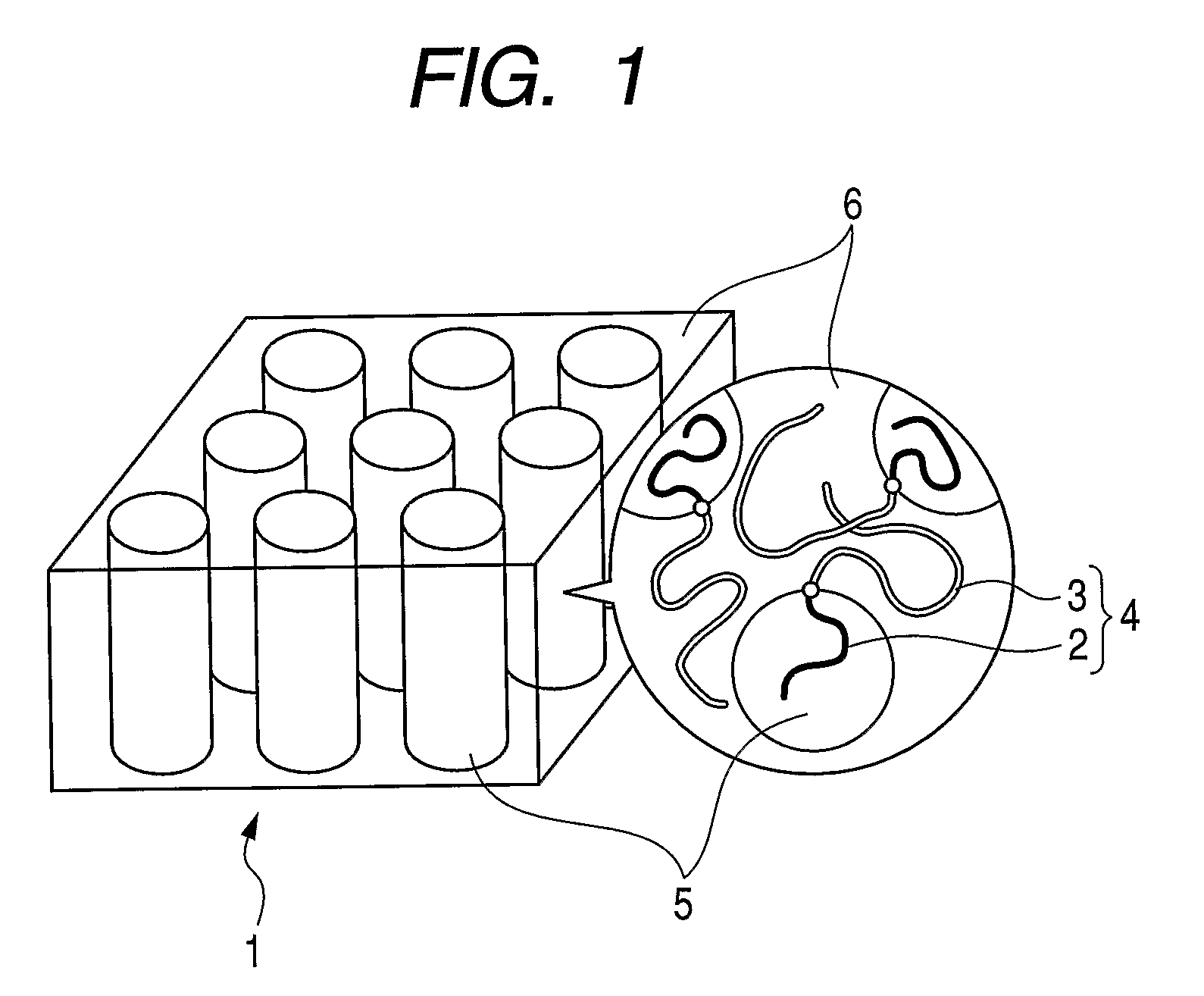Polymer electrolyte composite film, membrane-electrode assembly and fuel cell
a technology of electrolyte and composite film, which is applied in the direction of electrochemical generators, capacitors, vacuum evaporation coatings, etc., can solve the problems of low ion conductivity of membrane, difficult to allow heteropolyacids to be present, and difficult to control phase separation structure, etc., to achieve superior membrane properties, high proton conductivity, and high membrane strength
- Summary
- Abstract
- Description
- Claims
- Application Information
AI Technical Summary
Benefits of technology
Problems solved by technology
Method used
Image
Examples
synthesis example 1
Synthesis of Block Copolymer (BP-2) Composed of Carboxylic-Acid-Containing Block and Polystyrene Block
[0080]In an atmosphere of nitrogen, 0.6 millimoles of copper(I) bromide, 0.6 millimoles of 1,1,4,7,10,10-hexamethyltriethylenetetramine, 0.4 millimoles of methyl 2-bromopropionate and 50 millimoles of tert-butyl acrylate (tBA) were mixed, and then dissolved oxygen was displaced with nitrogen. Thereafter, reaction was carried out at 70° C. The reaction was performed while the rate of polymerization was ascertained by gas chromatography (GPC), and the reaction was quenched with liquid nitrogen. The molecular weight of poly-tBA obtained was ascertained by GPC to result in Mn=10,600 and Mw / Mn=1.07.
[0081]Next, 0.4 millimoles of the resulting poly-tBA having bromine at the terminal, 0.4 millimoles of copper(I) bromide, 0.4 millimoles of hexamethyltriethylenetetramine and 800 millimoles of styrene were mixed, followed by displacement with nitrogen. Reaction was carried out at 100° C., and ...
synthesis example 2
Synthesis of Block Copolymer (BP-3) Composed of Sulfonic-Acid-Containing Block and Polystyrene Block
[0083]The block copolymer BP-2 obtained in Synthesis Example 1 was dissolved in tetrahydrofuran (THF). To the solution obtained, sodium hydride (10 equivalent weight based on the carboxylic acid) and 1,3-propanesultone (20 equivalent weight based on the carboxylic acid) were added, and heat reflux was carried out to effect sulfonation of the PAA segment, to thereby obtain the desired block copolymer (BP-1) represented by the structural formula (1), having the sulfonic acid group as an ion exchange group. The volume fraction of the sulfonic-acid-containing block in BP-3 was 25%. The structural formula of this block copolymer PB-3 is shown below.
synthesis example 3
Synthesis of Carboxylic-Acid-Containing Random Copolymer (RP-2)
[0084]In an atmosphere of nitrogen, 0.13 millimoles of copper(I) bromide, 0.13 millimoles of 1,1,4,7,10,10-hexamethyltriethylenetetramine, 0.09 millimoles of 1-phenylethyl bromide, 40 millimoles of styrene monomer (St) and 10 millimoles of tert-butyl acrylate (tBA) were mixed, and then dissolved oxygen was displaced with nitrogen. Thereafter, reaction was carried out at 110° C. The reaction was performed while the rate of polymerization was ascertained by gas chromatography (GPC), and was quenched with liquid nitrogen. The molecular weight of PtBA-r-PSt (RP-1) obtained was ascertained by GPC to result in Mn=28,000 and Mw / Mn=1.99. The compositional ratio of St to tBA which was found from the ratio of peak integration values of 1H-NMR was tBA / St=50 / 212.
[0085]Next, the random copolymer RP-1 obtained was mixed with trifluoroacetic acid (5 equivalent weight based on the tert-butyl group) at room temperature in chloroform, and...
PUM
| Property | Measurement | Unit |
|---|---|---|
| Hydrophilicity | aaaaa | aaaaa |
Abstract
Description
Claims
Application Information
 Login to View More
Login to View More - R&D
- Intellectual Property
- Life Sciences
- Materials
- Tech Scout
- Unparalleled Data Quality
- Higher Quality Content
- 60% Fewer Hallucinations
Browse by: Latest US Patents, China's latest patents, Technical Efficacy Thesaurus, Application Domain, Technology Topic, Popular Technical Reports.
© 2025 PatSnap. All rights reserved.Legal|Privacy policy|Modern Slavery Act Transparency Statement|Sitemap|About US| Contact US: help@patsnap.com



